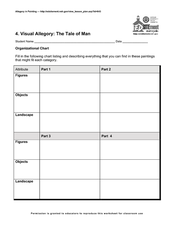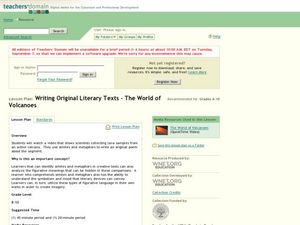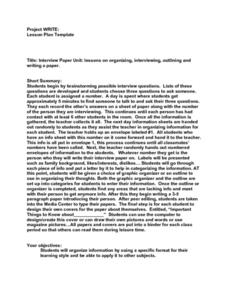Cornell University
Plant Cell Crime Scene
Use science to solve the mystery of the Poplar murder. Pupils use forensic botany to determine if a suspect could be the killer. By analyzing images from a Transmission Electron Microscope, learners determine if the material found on the...
CK-12 Foundation
Logarithm Properties: The Log Properties
Roll a log into an equivalent expression. Given four expanded logarithmic expressions, pupils write an equivalent condensed expression. They identify which properties allows for the simplification.
K20 LEARN
Simply Elementary, Watson!
Explore the process of inductive and deductive reasoning. A collaborative lesson has some groups apply an inductive approach and others a deductive approach. Through class discussion, scholars compare their processes and discuss...
Kenan Fellows
Attack of the Aphids!
Insects threaten the food production industry, and aphids are one of the big players! Analyzing data of aphid populations gives insight into their behaviors. Learners model the population data of an uninhibited population with an...
Curated OER
Positively Precise Organization
Fourth graders go online to critique the organization of student writing. They access the Yahooligans website to view the writing pieces. They utilize a worksheet imbedded in this plan which guides their scoring.
Curated OER
Notetaking Procedures
Sixth graders explore notetaking procedures. In this study skills lesson, 6th graders use text organizers to categorize information. Students select textbook sections and write headings, subheadings, and summary phrases for each...
Curated OER
Chemical Changes or Reactions
In this chemical changes worksheet, students create a concept map for chemical changes or reactions. They indicate the definition, the description, they give examples and they give non-examples in a graphic organizer.
Curated OER
Comparing Two Countries
In this history worksheet, students utilize a graphic organizer to write examples that are alike and different about two different countries.
Curated OER
Passive and Active Transport
In this transport worksheet, students compare and contrast the characteristics and examples of active transport and passive transport. This worksheet has 1 graphic organizer and 11 short answer questions.
Curated OER
Characterization
In this characterization graphic organizer worksheet, students provide examples of the speech, appearance, private thoughts, and actions of a character from a novel. Students also note how other characters react to the character.
Curated OER
CVC Word Review
In this CVC word review worksheet, students list CVC words in the "-an," "-ap," "-at," "-ed," "-en," and "-et" boxes on the graphic organizer. One example word is included in each of the boxes.
Curated OER
Analyzing and Evaluating Literary Works
Students evaluate the literary elements found in short stories. In this literature lesson, students read short stories of their choosing and list the examples of the literary elements they encounter in the story on the provided graphic...
Curated OER
Visual Allegory: The Tale of Man
In this visual allegory worksheet, high schoolers complete the provided graphic organizer that requires them to list details about examples of allegory in paintings.
Curated OER
Parts of Speech
In these language arts worksheets, students are provided with a graphic organizer depicting the grammatical parts of speech. Students examine the parts of speech and match each to its corresponding example.
Curated OER
Classifying Shapes Using Venn Diagrams
In this classifying shapes using Venn diagrams worksheet, students draw examples of isosceles, right, and equilateral triangles in the proper sections of the first graphic organizer. They draw polygons, both regular and quadrilaterals,...
Curated OER
Writing Original Literary Texts - The World of Volcanoes
Students watch a video about an active volcano and use similes and metaphors to write an original poem. In this poetry and volcano lesson plan, students define similes and metaphors and brainstorm examples. Students watch a video about...
Curated OER
Project WRITE: Class Interview Book
Get your language arts class moving, build community, and strengthen writing skills with this kinesthetic activity. The class brainstorms interview questions from which each chooses three. Individuals then collect information about six...
Curated OER
Connotation and Denotation:
Eighth graders investigate the effect that connotations can have on writing. They are shown examples to build background knowledge before attempting the exercise. They finish by writing a paragraph to practice what they have learned.
Curated OER
Who Am I? - Brainstorming
Students brainstorm lists of places, events and relationships that define them. They search for clip art and pictures in magazines to illustrate the items on their list and create a graphic timeline of their lives.
Curated OER
Classic Columns
Sixth graders present a PowerPoint presentation on Greek columns. They realize that Greek culture is centered around religion. Students create a model of one of the columns. Also they find examples of Greek architecture in major Greek...
Curated OER
Wuthering Heights: Questioning Strategy
Readers of Wuthering Heights use the DRTA strategy to formulate predictions about the actions of characters in Bronte's novel.
Curated OER
Journey to Topaz: Directed Reading Thinking Activity
Have you used the directed reading thinking activity in your classroom? Doubling as either a prereading strategy, or a during reading strategy, it helps readers connect the historical background of the text to the text itself. As the...
Do2Learn
Brainstorming Map Array
Getting ideas down on paper is often the first step when starting a project or new unit of study. Try out this straightforward brainstorming map with your class. Learners write in a topic and use the six bubbles that branch out of the...
Curated OER
Scientific Method
Students explore the scientific method. In this scientific method activity, students use information gathered from a "Seed Dispersal" lab done previously to complete a worksheet listing the steps of the scientific method.























